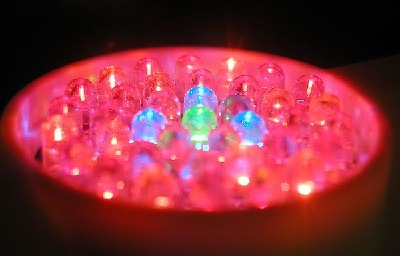
Marshall McLuhan once said, “It is the framework which changes with each new technology and not just the picture within the frame.” This is certainly the case with LED plant lighting. Creating a light source that does not create heat was a big breakthrough in grow lighting. With this breakthrough came a new variable for researchers looking to separate the light requirements and temperature requirements of plants. Traditional light sources such as HID, fluorescent, and the sun, are all radiant light sources that create heat. It follows logic that adding light meant adding heat. The problem was that the grow bulbs were creating more heat than the plants needed; translating into wasted energy in the form of creating the heat and more wasted energy managing the heat.
LED technology allowed us to remove the heat and focus only on the wavelengths that plants use for healthy growth, taste, and smell. Eliminating the heat is the major factor that allowed LED lighting to run on a fraction of the energy required for traditional lighting. Learning to garden without that heat is what is changing the framework for today’s LED gardener. This is most evident in the practice of using watts as a measurement of light output.
Determining light requirements by watts per square foot is a generalization that can and has worked for many gardeners using HPS or fluorescent. For example, a general rule of thumb found for fluorescent is 10-40 watts per square foot of garden, while HID lighting averages 50-250 watts per square foot of garden. The recommendations vary depending on what you are growing. This has worked in the past because it is safe to assume a 1,000 watt HID bulb puts out more light than a 400 watt HID bulb. We can also assume that two 1000 watt HPS bulbs, each from a different manufacturer, will emit a similar intensity over a set area when mounted at the same distance from the plants. Growers are accustomed to the idea that high watt is high output. That isn’t accurate with LED plant lighting.
Watts are not meant as a measurement of output but as a measurement of the energy consumed by plant lights. You will see a large range of efficiencies from one LED grow light to the next. This is almost entirely a reflection of heat management. There are 3 main types of LEDs used in LED plant lighting arrays: 5mm HBLEDs, 1 watt LEDs, and 3 watt LEDs. In the case of 5mm HBLEDs, the heat has been almost completely eliminated. Since the heat is not created, a well made 5mm HBLED array will not require cooling fans so the watts consumed translate directly into energy being used to create useable light. Five mm HBLEDs have the longest lifetime of the bunch; many are rated for 100,000 hours. Long lifetime is a direct result of managing heat in LEDs.
One watt and 3 watt LEDs are entirely different. These are considered high-watt LEDs. A 600 watt LED panel sounds like a powerful unit to a grower accustomed to the idea that high watt equals high output. When compared watt to watt to a 5mm panel, you will find that 600 watts of 5mm LEDs will go much farther than 600 watts of 1 or 3 watt LEDs.
Again, this is all tied into heat management. A 600 watt panel of 1 or 3 watt LEDs may require up to 10 cooling fans to operate. So while a 9 watt bar made up of 5mm HBLEDs uses 99% of the energy consumed directly to create light, a 600 watt panel uses up to 65% of the energy creating heat and running cooling fans to manage the heat. Even with the cooling fans, the heat has a dramatic effect on the lifetime of high wattage LEDs; the heat has already damaged the LEDs before the cooling fans can exhaust the heat. This shortens the 1 and 3 watt LEDs effective lifetime and burns out critical wavelength emissions.
For each 1 watt LED used, 12 square inches of heat sink is required to manage the heat produced by that single LED. Most 1 and 3 watt LEDs are rated for only 50,000 hours (1/2 the lifetime of 5mm LEDs.) In the world of LED plant lighting, determining light requirements via a watt-per-square-foot type guideline does not account for the amount of watt energy producing useable light vs. the amount of watt energy that is simply creating heat or powering cooling fans. In the world of LED plant lighting, it is not the number of watts, but how efficiently you can use a watt.
Angela Lundmark is a freelance writer that enjoys outdoor and indoor gardening.
Related Articles & Free Email Newsletter Sign Up
How to Optimize Light Intensity in an Indoor Garden
Understanding the 4 Types of Grow Lights




Comment here